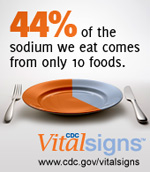 Most sodium comes from processed foods, restaurants and grocery stores.
Most sodium comes from processed foods, restaurants and grocery stores.

About 90% of Americans eat more sodium than is recommended for a healthy diet. Most of the sodium we eat comes from processed foods and foods prepared in restaurants. Sodium is already part of processed foods and cannot be removed.
However, manufacturers and restaurants can produce foods with less sodium. In addition, you can select lower sodium foods when possible and you can cook more foods yourself, to better control how much sodium you eat. The latest Vital Signs report finds that 10 types of foods are responsible for more than 40 percent of people’s sodium intake.
The most common sources are breads and rolls, luncheon meat such as deli ham or turkey, pizza, poultry, soups, cheeseburgers and other sandwiches, cheese, pasta dishes, meat dishes such as meat loaf, and snack foods such as potato chips, pretzels and popcorn. Some foods that are consumed several times a day, such as bread, add up to a lot of sodium even though each serving is not high in sodium. Top Sources of Sodium in the Diet
1. Breads and rolls
2. Cold cuts and cured meats
3. Pizza
4. Poultry
5. Soups
6. Sandwiches
7. Cheese
8. Pasta dishes
9. Meat dishes
10. Snacks “Too much sodium raises blood pressure, which is a major risk factor for heart disease and stroke,” said CDC Director Thomas R. Frieden, M. D., M. P. H.
“These diseases kill more than 800,000 Americans each year and contribute an estimated $273 billion in health care costs. “The report notes that the average person consumes about 3,300 milligrams of sodium per day, not including any salt added at the table, which is more than twice the recommended limit for about half of Americans and 6 of every 10 adults. The U.
S. Dietary Guidelines recommend limiting sodium intake to less than 2,300 milligrams per day. The recommendation is 1,500 milligrams per day for people aged 51 and older, and anyone with high blood pressure, diabetes, and chronic kidney disease, and African Americans.
Key points in the Vital Signs Report: Ten types of foods account for 44 percent of dietary sodium consumed each day. 65 percent of sodium comes from food sold in stores.
25 percent of sodium comes from meals purchased in restaurants. Reducing the sodium content of the 10 leading sodium sources by 25 percent would lower total dietary sodium by more than 10 percent and could play a role in preventing up to an estimated 28,000 deaths per year. Reducing daily sodium consumption is difficult since it is in so many of the foods we eat.
People can lower their sodium intake by eating a diet rich in fresh or frozen fruits and vegetables without sauce, while limiting the amount of processed foods with added sodium. Individuals can also check grocery food labels and choose the products lowest in sodium. CDC supports recommendations for food manufacturers and restaurants to reduce the amount of sodium added to foods.
“We’re encouraged that some food manufacturers are already taking steps to reduce sodium,” said Dr. Frieden. “Kraft Foods has committed to an average 10 percent reduction of sodium in their products over a two year period, and dozens of companies have joined a national initiative to reduce sodium.
The leading supplier of cheese for pizza, Leprino Foods, is actively working on providing customers and consumers with healthier options. We are confident that more manufacturers will do the same. “Understanding sodium in foods can be confusingTypes of foods matter: More than 40% of sodium comes from the following 10 types of foods: Breads and rolls, cold cuts and cured meats such as deli or packaged ham, or turkey, pizza, fresh and processed poultry, soups, sandwiches such as cheeseburgers, cheese, pasta dishes, meat-mixed dishes such as meat loaf with tomato sauce, and snacks such as chips, pretzels, and popcorn.
Sources of foods matter: About 65% of sodium eaten comes from food bought at retail stores, so look for lower sodium choices. About 25% comes from restaurants and it can be hard for a person to tell how much sodium is in restaurant foods. Brands of foods matter: Different brands of the same foods may have different sodium levels.
For example, sodium in chicken noodle soup can vary by as much as 840 milligrams (mg) per serving. To learn more about ways to reduce sodium, visit https://www. cdc.gov/salt. For more information on heart disease and stroke, visit https://www. cdc.gov/heartdisease/.
Reducing sodium is also a key component of the Million Hearts„ initiative to prevent a million heart attacks and strokes over the next five years. To learn how to reduce sodium using the DASH eating plan, visit https://www.nhlbi. nih. gov/health/health-topics/topics/dash/.
Vital Signs is a CDC report that appears on the first Tuesday of the month as part of the CDC journal, Morbidity and Mortality Weekly Report. The report provides the latest data and information on key health indicators. These are cancer prevention, obesity, tobacco use, motor vehicle passenger safety, prescription drug overdose, HIV/AIDS, alcohol use, health care-associated infections, cardiovascular health, teen pregnancy, asthma, and food safety.
CDC works 24/7 saving lives, protecting people from health threats, and saving money to have a more secure nation. Whether these threats are chronic or acute, manmade or natural, human error or deliberate attack, global or domestic, CDC is the U. S. health protection agency.

